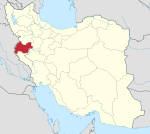world.wikisort.org - Iran
Sarpol-e Zahab (Persian: سرپل ذهاب, Sarpole Zahâb; Kurdish: Serpêllî Zehaw, سەرپێڵی زەهاو; also romanized as Sarpol-e Z̄ahāb, Sar-e Pol-e Z̄ahāb, and Sar-ī-Pūl Zūhāb; also known as Pol-e Z̄ahāb, Sarpole-Zahab, Pol-e Z̄ohāb, Sarī-Pūl, and Sarpol)[2] is a city and capital of Sarpol-e Zahab County, Kermanshah Province, Iran, close to the Iraqi border. At the 2006 census, its population was 34,632.[3]
Sarpol-e Zahab
سرپل ذهاب | |
|---|---|
Town | |
 | |
 Sarpol-e Zahab | |
| Coordinates: 34°27′40″N 45°51′46″E | |
| Country | Iran |
| Province | Kermanshah |
| County | Sarpol-e Zahab |
| Bakhsh | Central |
| Population (2016 Census) | |
| • Total | 45,481[1] |
| Time zone | UTC+3:30 (IRST) |
| • Summer (DST) | UTC+4:30 (IRDT) |
Demographics
The city is populated by Kurds.[4]
Reliefs
The area of Sar-e Pol-e Zahab has several more or less well preserved reliefs of the Lullubi kingdom, as well as a Parthian relief.
Lullubian reliefs
The most famous of these reliefs is the Anubanini rock relief. Another relief named Sar-e Pol-e Zohab I is about 200 meters away, in a style similar to the Anubanini relief, but this time with a beardless ruler.[5] The attribution to a specific ruler remains uncertain.[5] There are also other Lullubian relief in the same area of Sar-e Pol-e Zahab.[6]
- Sar-e Pol-e Zahab, relief I[5]
- Sar-e Pol-e Zahab, relief II: Anubanini rock relief[5]
- Sar-e Pol-e Zahab, relief III[5]
- Sar-e Pol-e Zahab, relief IV[5]
Parthian relief
Another relief is located below the Anubanini relief, lower on the cliff. This relief was created during the Parthian Empire in the name of Gotarzes, possibly Gotarzes I, but more probably the Parthian king Gotarzes II, who ruled from 39 to 51 CE and is known to have made other reliefs, such as the equestrian relief at Behistun.[7][8]
- The second relief, below the Anubanini relief, a Parthian relief.
 Drawing of the Parthian relief.
Drawing of the Parthian relief.
References
- "Statistical Center of Iran > Home". www.amar.org.ir.
- Sarpol-e Zahab can be found at GEOnet Names Server, at this link, by opening the Advanced Search box, entering "-3078472" in the "Unique Feature Id" form, and clicking on "Search Database".
- "Census of the Islamic Republic of Iran, 1385 (2006)" (Excel). Statistical Center of Iran. Archived from the original on 2011-11-11.
- "Language distribution: Kermanshah Province". Iran Atlas. Retrieved 27 March 2021.
{{cite web}}: CS1 maint: url-status (link) - Osborne, James F. (2014). Approaching Monumentality in Archaeology. SUNY Press. pp. 123–124. ISBN 9781438453255.
- Vanden Berghe, Louis. Relief Sculptures de Iran Ancien. pp. 19-21.
- Vanden Berghe, Louis. Relief Sculptures de Iran Ancien. p. 45.
- Deuren, Greet van (2017). Iran (in Dutch). Gottmer Uitgevers Groep b.v. ISBN 9789025763961.
На других языках
[de] Sarpol-e Sahab
Sarpol-e Sahab (persisch سرپل ذهاب, DMG Sarpol-i Ẕahāb, kurdisch .mw-parser-output .Arab a,.mw-parser-output a bdi.Arab{text-decoration:none!important}.mw-parser-output .Arab{font-size:120%}سەرپێڵی زەهاو .mw-parser-output .Latn{font-family:"Akzidenz Grotesk","Arial","Avant Garde Gothic","Calibri","Futura","Geneva","Gill Sans","Helvetica","Lucida Grande","Lucida Sans Unicode","Lucida Grande","Stone Sans","Tahoma","Trebuchet","Univers","Verdana"}Serpêllî Zehaw) ist eine Stadt in der iranischen Provinz Kermānschāh in der Nähe der Grenze zum Irak. Sie steht an der Stelle des historischen Hulwan und ist damit das Tor zum geschichtsträchtigen Paitak Pass, der über das Zāgros-Gebirge ins Iranische Binnenbecken führt.[2][3] Die Hauptstadt des gleichnamigen Verwaltungsbezirks liegt im Zāgros-Gebirge und ist mehrheitlich von Kurden bewohnt.- [en] Sarpol-e Zahab
[ru] Сере-Поле-Зохаб
Сере-Поле-Зохаб[1] (перс. سرپل ذهاب) — приграничный город на западе Ирана, в провинции Керманшах. Административный центр шахрестана Сарполь-э-Захаб.Другой контент может иметь иную лицензию. Перед использованием материалов сайта WikiSort.org внимательно изучите правила лицензирования конкретных элементов наполнения сайта.
WikiSort.org - проект по пересортировке и дополнению контента Википедии
![Sar-e Pol-e Zahab, relief I[5]](http://upload.wikimedia.org/wikipedia/commons/thumb/0/07/Sar-e_Pol-e_Zahab%2C_relief_IV.jpg/200px-Sar-e_Pol-e_Zahab%2C_relief_IV.jpg)
![Sar-e Pol-e Zahab, relief II: Anubanini rock relief[5]](http://upload.wikimedia.org/wikipedia/commons/thumb/4/4d/Anubanini_Rock_Relief_1.jpg/200px-Anubanini_Rock_Relief_1.jpg)
![Sar-e Pol-e Zahab, relief III[5]](http://upload.wikimedia.org/wikipedia/commons/thumb/6/63/Sar-e_Pol-e_Zahab%2C_relief_II.jpg/200px-Sar-e_Pol-e_Zahab%2C_relief_II.jpg)
![Sar-e Pol-e Zahab, relief IV[5]](http://upload.wikimedia.org/wikipedia/commons/thumb/b/bd/Sar-e_Pol-e_Zahab%2C_relief_III.jpg/200px-Sar-e_Pol-e_Zahab%2C_relief_III.jpg)


